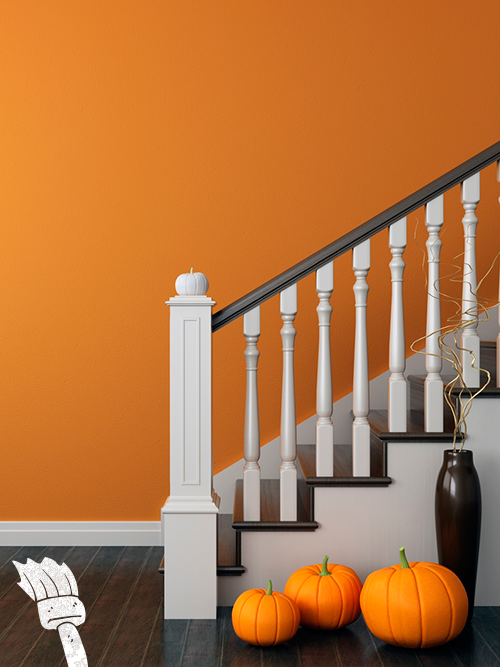Welcome to our new blog! Once a month we will be posting helpful tips on selecting paint and decorating the interior and exterior of your property. Our aim is to help you choose products to get your decorating completed quickly, simply and the first time around. We hope you enjoy our first post on choosing and testing out colour…
Autumn is now well and truly upon us with the colours of the glorious Dorset countryside painting a picture of bonfire night, mulled wine and log fires. As we batten down our hatches against the elements, thoughts turn to creating a warm and inviting atmosphere to entertain friends and family as the nights lengthen and the cold returns.
Moving back indoors is a great time of the year to review colour schemes and plan any changes before the busy holiday season is upon us. As we all know, DIY always seem to take longer to complete than we expect!
An injection of colour can re-invigorate our senses and mood, however choosing the perfect shade is often the lengthiest task of all! The autumn landscape with its rich and earthy tones is a good place to find inspiration to re-decorate any room that needs a little more warmth. If you’re wary of painting a whole room in a deeper colour - which could make the room appear smaller - you could choose to just paint a feature wall, an alcove or maybe some items of furniture.
Unless you are lucky enough to be planning a major overhaul, you’ll need to bear in mind that your new colour will have to match, tone or complement your existing furnishings. Establishing exactly what colours you already have is a good place to start, to create a balanced, cohesive scheme. In our experience, when faced with all the shades we have to offer, customers often have difficulty pinpointing exact matches from memory. It is therefore a good idea to match swatches to items that need to be retained in the room to provide a colour palette; or you can simply take in a selection of key pieces and try out potential new colours against them. We would advise you choose from individual swatches, if at all possible, to give the widest choice and most accurate representation of colour.
Once you have a colour in mind, try it out first, as the aspect of the room combined with lighting and furnishings will play a part in deciding if the colour looks right. Emulsion tester pots can be mixed that should be applied to different walls to give you a good idea of how the colour looks in different lights at different times of the day. Deeper colours will probably need a few coats and the colour may take up to a week or two to fully develop so you may need to be a little patient at this point. Living with the new colour for a while can also help you to decide if it’s for you.
While you are in the creative process of choosing the perfect shade, you can get ahead by preparing your surfaces ready for painting. This will help to speed up the decorating project and give you the basis for a beautiful and long lasting finish. We’ll cover that next time...
Autumn is now well and truly upon us with the colours of the glorious Dorset countryside painting a picture of bonfire night, mulled wine and log fires. As we batten down our hatches against the elements, thoughts turn to creating a warm and inviting atmosphere to entertain friends and family as the nights lengthen and the cold returns.
Moving back indoors is a great time of the year to review colour schemes and plan any changes before the busy holiday season is upon us. As we all know, DIY always seem to take longer to complete than we expect!
An injection of colour can re-invigorate our senses and mood, however choosing the perfect shade is often the lengthiest task of all! The autumn landscape with its rich and earthy tones is a good place to find inspiration to re-decorate any room that needs a little more warmth. If you’re wary of painting a whole room in a deeper colour - which could make the room appear smaller - you could choose to just paint a feature wall, an alcove or maybe some items of furniture.
Unless you are lucky enough to be planning a major overhaul, you’ll need to bear in mind that your new colour will have to match, tone or complement your existing furnishings. Establishing exactly what colours you already have is a good place to start, to create a balanced, cohesive scheme. In our experience, when faced with all the shades we have to offer, customers often have difficulty pinpointing exact matches from memory. It is therefore a good idea to match swatches to items that need to be retained in the room to provide a colour palette; or you can simply take in a selection of key pieces and try out potential new colours against them. We would advise you choose from individual swatches, if at all possible, to give the widest choice and most accurate representation of colour.
Once you have a colour in mind, try it out first, as the aspect of the room combined with lighting and furnishings will play a part in deciding if the colour looks right. Emulsion tester pots can be mixed that should be applied to different walls to give you a good idea of how the colour looks in different lights at different times of the day. Deeper colours will probably need a few coats and the colour may take up to a week or two to fully develop so you may need to be a little patient at this point. Living with the new colour for a while can also help you to decide if it’s for you.
While you are in the creative process of choosing the perfect shade, you can get ahead by preparing your surfaces ready for painting. This will help to speed up the decorating project and give you the basis for a beautiful and long lasting finish. We’ll cover that next time...



 RSS Feed
RSS Feed
